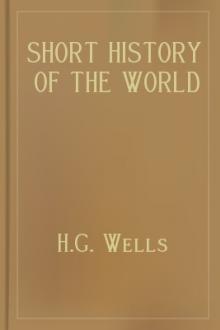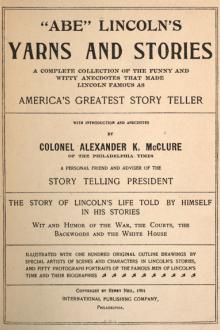A Short History of the World, H. G. Wells [beach books .TXT] 📗

- Author: H. G. Wells
- Performer: -
Book online «A Short History of the World, H. G. Wells [beach books .TXT] 📗». Author H. G. Wells
Photo: Alinari
Photo: Underwood & Underwood
Both Ardashir I who founded the Sassanid dynasty in the third century A.D., and Constantine the Great who reconstructed the Roman Empire in the fourth, turned to religious organizations for help, because in these organizations they saw a new means of using and controlling the wills of men. And already before the end of the fourth century both empires were persecuting free talk and religious innovation. In Persia Ardashir found the ancient Persian religion of Zoroaster (or Zarathushtra) with its priests and temples and a sacred fire that burnt upon its altars, ready for his purpose as a state religion. Before the end of the third century Zoroastrianism was persecuting Christianity, and in 277 A.D. Mani, the founder of a new faith, the Manichæans, was crucified and his body flayed. Constantinople, on its side, was busy hunting out Christian heresies. Manichæan ideas infected Christianity and had to be fought with the fiercest methods; in return ideas from Christianity affected the purity of the Zoroastrian doctrine. All ideas became suspect. Science, which demands before all things the free action of an untroubled mind, suffered a complete eclipse throughout this phase of intolerance.
War, the bitterest theology, and the usual vices of mankind constituted Byzantine life of those days. It was picturesque, it was romantic; it had little sweetness or light. When Byzantium and Persia were not fighting the barbarians from the north, they wasted Asia Minor and Syria in dreary and destructive hostilities. Even in close alliance these two empires would have found it a hard task to turn back the barbarians and recover their prosperity. The Turks or Tartars first come into history as the allies first of one power and then of another. In the sixth century the two chief antagonists were Justinian and Chosroes I; in the opening of the seventh the Emperor Heraclius was pitted against Chosroes II (580).
At first and until after Heraclius had become Emperor (610) Chosroes II carried all before him. He took Antioch, Damascus and Jerusalem and his armies reached Chalcedon, which is in Asia Minor over against Constantinople. In 619 he conquered Egypt. Then Heraclius pressed a counter attack home and routed a Persian army at Nineveh (627), although at that time there were still Persian troops at Chalcedon. In 628 Chosroes II was deposed and murdered by his son, Kavadh, and an inconclusive peace was made between the two exhausted empires.
Byzantium and Persia had fought their last war. But few people as yet dreamt of the storm that was even then gathering in the deserts to put an end for ever to this aimless, chronic struggle.
While Heraclius was restoring order in Syria a message reached him. It had been brought in to the imperial outpost at Bostra south of Damascus; it was in Arabic, an obscure Semitic desert language, and it was read to the Emperor, if it reached him at all, by an interpreter. It was from someone who called himself “Muhammad the Prophet of God.” It called upon the Emperor to acknowledge the One True God and to serve him. What the Emperor said is not recorded.
A similar message came to Kavadh at Ctesiphon. He was annoyed, tore up the letter, and bade the messenger begone.
This Muhammad, it appeared, was a Bedouin leader whose headquarters were in the mean little desert town of Medina. He was preaching a new religion of faith in the One True God.
“Even so, O Lord!” he said; “rend thou his Kingdom from Kavadh.”
THROUGHOUT the fifth, sixth, seventh and eighth centuries, there was a steady drift of Mongolian peoples westward. The Huns of Attila were merely precursors of this advance, which led at last to the establishment of Mongolian peoples in Finland, Esthonia, Hungary and Bulgaria, where their descendants, speaking languages akin to Turkish, survive to this day. The Mongolian nomads were, in fact, playing a role towards the Aryanized civilizations of Europe and Persia and India that the Aryans had played to the Ægean and Semitic civilizations ten or fifteen centuries before.
In Central Asia the Turkish peoples had taken root in what is now Western Turkestan, and Persia already employed many Turkish officials and Turkish mercenaries. The Parthians had gone out of history, absorbed into the general population of Persia. There were no more Aryan nomads in the history of Central Asia; Mongolian people had replaced them. The Turks became masters of Asia from China to the Caspian.
The same great pestilence at the end of the second century A.D. that had shattered the Roman Empire had overthrown the Han dynasty in China. Then came a period of division and of Hunnish conquests from which China arose refreshed, more rapidly and more completely than Europe was destined to do. Before the end of the sixth century China was reunited under the Suy dynasty, and this by the time of Heraclius gave place to the Tang dynasty, whose reign marks another great period of prosperity for China.
Specimens in glazed earthenware, in brown, green and buff, discovered in tombs in China
(In the Victoria and Albert Museum)
Throughout the seventh, eighth and ninth centuries China was the most secure and civilized country in the world. The Han dynasty had extended her boundaries in the north; the Suy and Tang dynasties now spread her civilization to the south, and China began to assume the proportions she has to-day. In Central Asia indeed she reached much further, extending at last, through tributary Turkish tribes, to Persia and the Caspian Sea.
The new China that had arisen was a very different land from the old China of the Hans. A new and more vigorous literary school appeared, there was a great poetic revival; Buddhism had revolutionized philosophical and religious thought. There were great advances in artistic work, in technical skill and in all the amenities of life. Tea was first used, paper manufactured and wood-block printing began. Millions of people indeed were leading orderly, graceful and kindly lives in China during these centuries when the attenuated populations of Europe and Western Asia were living either in hovels, small walled cities or grim robber fortresses. While the mind of the west was black with theological obsessions, the mind of China was open and tolerant and enquiring.
One of the earliest monarchs of the Tang dynasty was Tai- tsung, who began to reign in 627, the year of the victory of Heraclius at Nineveh. He received an embassy from Heraclius, who was probably seeking an ally in the rear of Persia. From Persia itself came a party of Christian missionaries (635). They were allowed to explain their creed to Tai-tsung and he examined a Chinese translation of their Scriptures. He pronounced this strange religion acceptable, and gave permission for the foundation of a church and monastery.
To this monarch also (in 628) came messengers from Muhammad. They came to Canton on a trading ship. They had sailed the whole way from Arabia along the Indian coasts. Unlike Heraclius and Kavadh, Tai-Tsung gave these envoys a courteous hearing. He expressed his interest in their theological ideas and assisted them to build a mosque in Canton, a mosque which survives, it is said, to this day, the oldest mosque in the world.
A PROPHETIC amateur of history surveying the world in the opening of the seventh century might have concluded very reasonably that it was only a question of a few centuries before the whole of Europe and Asia fell under Mongolian domination. There were no signs of order or union in Western Europe, and the Byzantine and Persian Empires were manifestly bent upon a mutual destruction. India also was divided and wasted. On the other hand China was a steadily expanding empire which probably at that time exceeded all Europe in population, and the Turkish people who were growing to power in Central Asia were disposed to work in accord with China. And such a prophecy would not have been an altogether vain one. A time was to come in the thirteenth century when a Mongolian overlord would rule from the Danube to the Pacific, and Turkish dynasties were destined to reign over the entire Byzantine and Persian Empires, over Egypt and most of India.
Where our prophet would have been most likely to have erred would have been in under-estimating the recuperative power of the Latin end of Europe and in ignoring the latent forces of the Arabian desert. Arabia would have seemed what it had been for times immemorial, the refuge of small and bickering nomadic tribes. No Semitic people had founded an empire now for more than a thousand years.
Then suddenly the Bedouin flared out for a brief century of splendour. They spread their rule and language from Spain to the boundaries of China. They gave the world a new culture. They created a religion that is still to this day one of the most vital forces in the world.
The man who fired this Arab flame appears first in history as the young husband of the widow of a rich merchant of the town of Mecca, named Muhammad. Until he was forty he did very little to distinguish himself in the world. He seems to have taken considerable interest in religious discussion. Mecca was a pagan city at that time worshipping in particular a black stone, the Kaaba, of great repute throughout all Arabia and a centre of pilgrimages; but there were great numbers of Jews in the country—indeed all the southern portion of Arabia professed the Jewish faith—and there were Christian churches in Syria.
About forty Muhammad began to develop prophetic characteristics like those of the Hebrew prophets twelve hundred years before him. He talked first to his wife of the One True God, and of the rewards and punishments of virtue and wickedness. There can be no doubt that his thoughts were very strongly influenced by Jewish and Christian ideas. He gathered about him a small circle of believers and presently began to preach in the town against the prevalent idolatry. This made him extremely unpopular with his fellow townsmen because the pilgrimages to the Kaaba were the chief source of such prosperity as Mecca enjoyed. He became bolder and more definite in his teaching, declaring himself to be the last chosen prophet of God entrusted with a mission to perfect religion. Abraham, he declared, and Jesus Christ were his forerunners. He had been chosen to complete and perfect the revelation of God’s will.
He produced verses which he said had been communicated to him by an angel, and he had a strange vision in which he was taken up through the Heavens to God and instructed in his mission.





Comments (0)